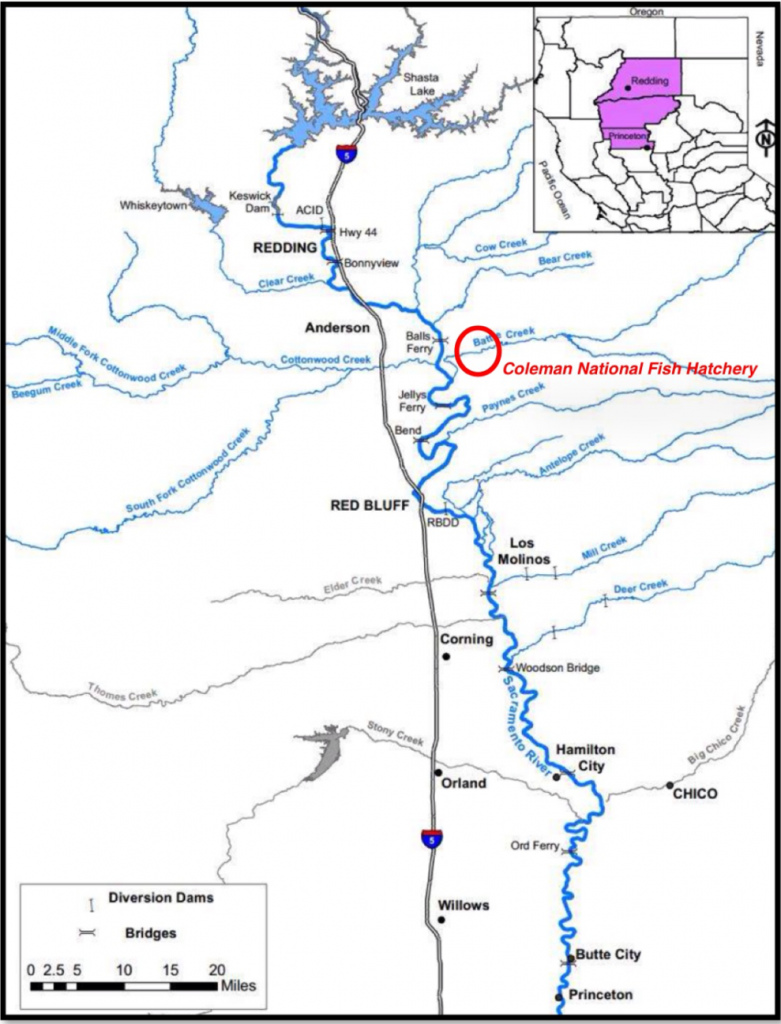The Coleman National Fish Hatchery (CNFH) on lower Battle Creek near Redding, CA (see map below) was constructed in 1942 to mitigate for the Shasta Dam project on the Sacramento built just upstream from Redding. It annually produces 12,000,000 fall-run salmon smolts and a million late–fall-run salmon smolts. Operation of CNFH is in need of reform because it fails to meet its mitigation goal and because it may interfere with the Battle Creek Restoration Program (BCRP1).
Efforts to improve salmon runs in recent drought years by trucking smolts to the lower river and Bay-Delta have resulted in increased straying of CNFH adult salmon to other Central Valley Rivers.2 Releasing millions of smolts into lower Battle Creek at the hatchery negatively affects wild smolts emigrating from Battle Creek through competition and stimulation of an annual spring striped bass feeding frenzy in the Sacramento River.3 Straying also limits adult salmon return to the hatchery and in some years makes it difficult for the hatchery to meet egg quotas. Plans to reduce these conflicts have drawn criticism from fishermen groups4 because of the potential of reducing smolt production and survival, and subsequent fishery harvests. CNFH production likely contributes a third or more of California’s ocean and freshwater salmon catch, and is a major contributor to natural salmon spawning in the Central Valley.
Recommendations
- In the Central Valley Salmon Recovery Plan (NMFS 2009/2011, p. 201), NMFS suggests moving the production hatchery to the Sacramento River from Battle Creek to reduce conflicts. The existing hatchery could be used as a conservation hatchery to support recovery of wild Battle Creek salmon and steelhead.
- Fall-run salmon smolt production should be trucked/barged to the Bay to maximize contribution to fisheries, recognizing substantial straying of fall-run occurs throughout the Central Valley. Barging smolts from above the mouth of the Feather River to the Bay should reduce straying to the Feather, American, and San Joaquin rivers and their tributaries.
- Fall-run CNFH fry can be trucked/barged to high quality lower river floodplain and tidal estuary habitats historically important to fall-run, but presently unavailable or unreachable. Such habitats were important and reachable before the dams were built.
- Late-fall-run and steelhead smolts should be released at the hatchery in wet winters, but barged to the Bay in dry years.
- http://www.usbr.gov/mp/battlecreek/docs/pd-cnfhamp.pdf ↩
- https://nrm.dfg.ca.gov/FileHandler.ashx?DocumentID=99281 ↩
- http://calsport.org/fisheriesblog/?p=878 ; http://www.wonews.com/t-NorthernCAFreshwater_Colusa_050516.aspx ↩
- http://www.goldengatesalmon.org/state-decision-to-dump-salmon-opposed-by-salmon-fishermen/ ↩

